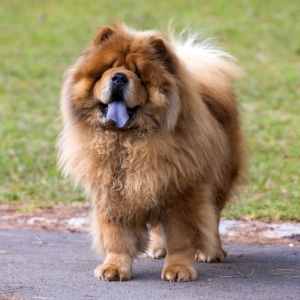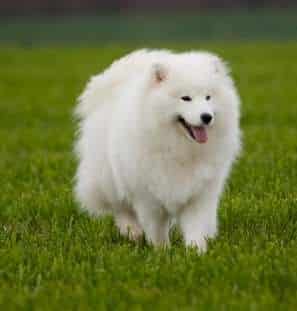Spitz dogs all have a few things in common …
The Dog Breed group of Spitz Dogs are a special family. They were all bred for cold conditions in North America, Russia and Scandinavia. They have wedge-shaped head, pointed erect ears, a thick double coat, and their tail usually curls over the dogs back.

Spitz Dogs – Temperament
Spitz breeds were originally developed to work, and they are intelligent and independent. They were used for hunting moose and bears, for hauling heavy sleds, and for herding animals such as reindeer.
Many Spitz dogs still have an innate suspicion of strangers and other dogs. They are not easy to train, and need thorough socialization from an early age to make them comfortable in an urban environment. Other members of the group such as the Pomeranian have been bred more recently to be companion dogs, and are therefore less remote or detached than the (typically) bigger breeds of Spitz.
Spitz Dogs – the Breeds
This list of Spitz dogs is not exhaustive, and concentrates on the more popular breeds. We have breed-specific pages with more information on most of the breeds here, and we are adding pages regularly.
American Akita

The American Akita is a loyal, alert dog with a strong, muscular body build. The breed is well known for its intelligence, with many being seen performing in obedience trials. While these dogs have plenty of energy to spare, they’re not known for being particularly outward-going with it.
Many people do not realize that the American Akita and the Japanese Akita Inu are two separate breeds. But what differentiates them? You can break down the differences in color, body shape, size and personality.
Akita Inu

Akita Inu dogs are strong, independent and dominant. They can be aloof with strangers but affectionate and loving with family members. They are not for the novice dog owner and require strong handling.
These Japanese fighting dogs are the largest of the Spitz group and were originally bred to fight and hunt bears and to guard Japanese royalty. They are solid muscular dogs with webbed feet which make them extremely strong swimmers along with a strong and imposing stature.
Alaskan Klee Kai

You may have heard of Alaskan Klee Kais, but you probably haven’t seen one; they are relatively rare, and were only recognized by the AKC in 1997. With the Alaskan Husky as a forebear, the Alaskan Klee Kai belongs to the Spitz family of dogs. It is significantly smaller than the Husky, however, and many people think it is still a puppy, even when fully-grown.
Alaskan Malamute

These dogs are loyal and happy to be around their families, however, they are not very well suited to share the house with other dogs. While they tend to coexist better with dogs of their own breed, it’s recommended that they have lots of space to move around in alone.
American Eskimo Dog

These dogs are small enough to live in apartments, so long as they get ample exercise. This being said, they are not best for owners who will not be home for most of the day, as they are prone to separation anxiety and will bark as a result.
The American Eskimo Dog is a great, fun pet for families with children of any age. Due to their size and reserved, yet playful behavior, these dogs play well with kids.
Chow Chow

This breed is known to be independent as well, living alongside its owners like another member of the house. It particularly does not like being pampered, and will dislike the idea of assuming the role of a lap dog.
Chows are notoriously very suspicious of strangers. They will only accept a new person’s presence if they are introduced formally by the owner.
Finnish Lapphund

Origins: Finland
Size: Medium to Large
Grooming: Average
Training: Easy
Recognition: FCI Group 5 , AKC FSS, ANKC Working Dogs , CKC Herding, KC (UK) Pastoral, NZKC Working , UKC Northern Breeds
Finnish Spitz

Origins: Finland
Size: Medium to Large
Grooming: Average
Training: Average
Recognition: FCI Group 5, AKC Non-sporting, ANKC Hounds, CKC Hounds, KC (UK) Hound, NZKC Hounds, UKC Northern Breed
Icelandic Sheepdog

Origins: Iceland
Size: Medium
Grooming: Average
Training: Average
Recognition: FCI: Group 5, AKC: FSS (Herding). CKC: Herding, UKC: Herding
Keeshond

Origins: The Netherlands
Size: Medium
Grooming: Extensive
Training: Easy
Recognition: FCI: Group 5, AKC: Non-sportingA, NKC: Non-sporting, CKC: Non-sporting, KC: Utility, NZKC: Non-sporting, UKC: Northern
Norwegian Buhond

Origins: Norway
Size: Large
Grooming: Average
Training: Average
Recognition: FCI: Group 5, AKC: Herding, ANKC: Working, CKC: Herding, KC: Pastoral, NZKC: Working, UKC: Northern Breeds
Norwegian Elkhound

Origins: Norway
Size: Medium
Grooming: Average
Training: Time Consuming
Recognition: FCI: Group 5, AKC: Hounds, ANKC: Hounds, CKC: Hounds, KC: Hounds, NZKC: Hounds, UKC: Northern Breeds
Norwegian Lundehund

Origins: Norway
Size: Small
Grooming: Average
Training: Time Consuming
Recognition: FCI: Group 5 , AKC: Non-sporting, CKC: Hounds, UKC: Northern Breeds
Samoyed

The Samoyed is also called “Smiling Sammie” because their lips turn up, making it appear like they are smiling at you, making for a picture perfect dog.
This is a breed that is adaptable, friendly, and overall outgoing and playful. Samoyeds make excellent pets for nearly everyone, considering they even get along extremely well with small children and other dogs.
Shiba Inu

The Shiba Inu is a compact breed of loyal, determined, and alert dogs. These dogs are well known for their intelligence and are considered one of the most popular breeds in Japan.
The Shiba Inu’s small size and reserved personality may be suitable for apartment living. However, with their tendency to vocalize, they may not be the best choice for those living in high population density areas.
Siberian Husky

Origins: Russia
Size: Medium, to Large
Grooming: Average
Training: Average to Time Consuming
Recognition: FCI: Group 5, AKC: Working, ANKC: Utility, CKC: Working, KC: Working, NZKC: Utility, UKC: Northern Breeds
Swedish Valhund

Origins: Sweden
Size: Small to Medium
Grooming: Average
Training: Average
Recognition: FCI: Group 5, AKC: Herding, KC: Pastoral, NZKC: Working, UKC: Herding



